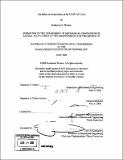The effect of doxorubicin on the U2OS cell cycle
Author(s)
Weston, Katherine D
DownloadFull printable version (18.76Mb)
Other Contributors
Massachusetts Institute of Technology. Dept. of Mechanical Engineering.
Advisor
Gerard Ostheimer and Nicholas G. Hadjiconstantinou.
Terms of use
Metadata
Show full item recordAbstract
Treatment of U20S cells with the chemotherapeutic drug Doxorubicin results in either apoptosis or cellular senescence. The pathway the cell takes is dependent upon the dosage of Doxorubicin administered to the cells. When a 10 [mu]M dose is administered Topoisomerase II is inhibited resulting in double stranded DNA breaks because the DNA is unable to relegate during synthesis. This is shown by lower levels of synthesis after analysis with Bro mo-2-deoxyuridine (BrdU) and Propidium Iodide (PI) staining. The cells are unable to recover from the severity of this damage and become apoptotic. When a 2 [mu]M dose is applied to the cells, a G2 arrest occurs. This is shown by lower levels of Cyclin B in the G2 phase during flow cytometry analysis and staining with PI. Apoptosis levels are monitored using cleaved Caspase 3 and cleaved PARP. The percentage of 10 [mu]M cells undergoing apoptosis increased steadily over 48 hours, while the 2 [mu]M and untreated cells maintained constant low levels of apoptosis. Both cellular senescence and apoptosis put a halt to cell proliferation.
Description
Thesis (S.B.)--Massachusetts Institute of Technology, Dept. of Mechanical Engineering, 2008. Includes bibliographical references (leaves 26-28).
Date issued
2008Department
Massachusetts Institute of Technology. Department of Mechanical EngineeringPublisher
Massachusetts Institute of Technology
Keywords
Mechanical Engineering.